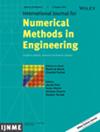Structural Topology Optimization With the Simultaneous Constraints to Maximum Contact Pressure and Fatigue Damage
Abstract
In this work, we develop a topology optimization method for elastic contact problems involving fatigue constraints under proportional loads. The method is formulated by means of B-spline parameterization of the pseudo-density field to describe the material layout. Both the contact pressure control on the contact surface and fatigue constraint to the whole structure domain are taken into account simultaneously. The accumulated fatigue damage related to the fatigue constraint is calculated based upon the rainflow-counting scheme, Sines method, S–N curve and Palmgren–Miner's linear damage hypothesis. The Kreisselmeier–Steinhauser (KS) function is adopted as an aggregated measure for both the maximum contact pressure and the maximum fatigue damage. The design sensitivities are derived analytically using the adjoint method. Both frictionless and frictional contact problems are investigated. The influence of fatigue constraints on the optimization result is discussed in comparison with the standard compliance minimization. Frictional contact effects upon the optimized results and fatigue damage are highlighted. Results show that the maximum contact pressure and maximum fatigue damage can effectively be controlled to avoid fatigue failure and that the fatigue strength of the structure can be improved at the cost of structural stiffness.

 求助内容:
求助内容: 应助结果提醒方式:
应助结果提醒方式:


